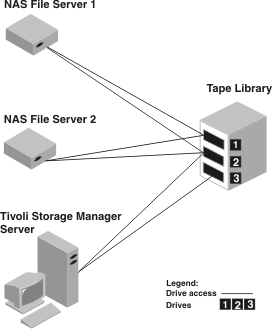Determining library drive usage when backing up to NAS-attached libraries
Drives can be used for multiple purposes because of the flexible configurations allowed by Tivoli® Storage Manager. For NDMP operations, the NAS file server must have access to the drive. The Tivoli Storage Manager server can also have access to the same drive, depending on your hardware connections and limitations.
About this task

To create the configuration shown in Figure 1, perform the following steps:
Procedure
- Define all three drives to Tivoli Storage Manager.
- Define paths from the Tivoli Storage Manager server to drives 2 and 3. Because drive 1 is not accessed by the server, no path is defined.
- Define each NAS file server as a separate data mover.
- Define paths from each data mover to drive 1 and to drive 2.
Results
To use the Tivoli Storage Manager back end data movement operations, the Tivoli Storage Manager server requires two available drive paths from a single NAS data mover. The drives can be in different libraries and can have different device types that are supported by NDMP. You can make copies between two different tape devices, for example, the source tape drive can be an DLT drive in a library and the target drive can be an LTO drive in another library.
During Tivoli Storage Manager back end data movements, the Tivoli Storage Manager server locates a NAS data mover that supports the same data format as the data to be copied from and that has two available mount points and paths to the drives. If the Tivoli Storage Manager server cannot locate such a data mover, the requested data movement operation is not performed. The number of available mount points and drives depends on the mount limits of the device classes for the storage pools involved in the back end data movements.
If the back end data movement function supports multiprocessing, each concurrent Tivoli Storage Manager back end data movement process requires two available mount points and two available drives. To run two Tivoli Storage Manager processes concurrently, at least four mount points and four drives must be available.
See Defining paths for NDMP operations for more information.